Related Research Articles

An electronic oscillator is an electronic circuit that produces a periodic, oscillating electronic signal, often a sine wave or a square wave or a triangle wave. Oscillators convert direct current (DC) from a power supply to an alternating current (AC) signal. They are widely used in many electronic devices ranging from simplest clock generators to digital instruments and complex computers and peripherals etc. Common examples of signals generated by oscillators include signals broadcast by radio and television transmitters, clock signals that regulate computers and quartz clocks, and the sounds produced by electronic beepers and video games.
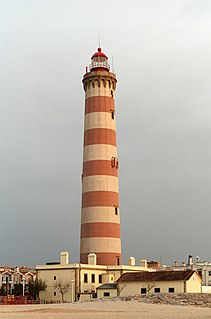
A lighthouse is a tower, building, or other type of structure designed to emit light from a system of lamps and lenses and to serve as a beacon for navigational aid, for maritime pilots at sea or on inland waterways.

A telephone is a telecommunications device that permits two or more users to conduct a conversation when they are too far apart to be heard directly. A telephone converts sound, typically and most efficiently the human voice, into electronic signals that are transmitted via cables and other communication channels to another telephone which reproduces the sound to the receiving user. The term is derived from Greek: τῆλε and φωνή, together meaning distant voice. A common short form of the term is phone, which came into use almost immediately after the first patent was issued.
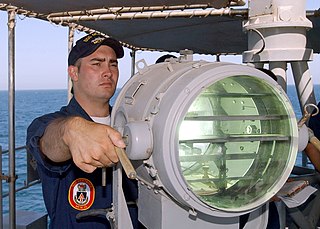
Optical communication, also known as optical telecommunication, is communication at a distance using light to carry information. It can be performed visually or by using electronic devices. The earliest basic forms of optical communication date back several millennia, while the earliest electrical device created to do so was the photophone, invented in 1880.
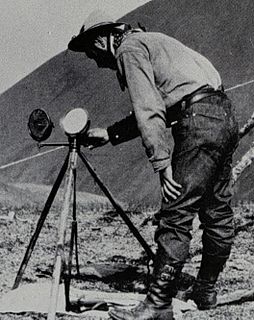
A heliograph is a semaphore system that signals by flashes of sunlight reflected by a mirror. The flashes are produced by momentarily pivoting the mirror, or by interrupting the beam with a shutter. The heliograph was a simple but effective instrument for instantaneous optical communication over long distances during the late 19th and early 20th century. Its main uses were military, survey and forest protection work. Heliographs were standard issue in the British and Australian armies until the 1960s, and were used by the Pakistani army as late as 1975.
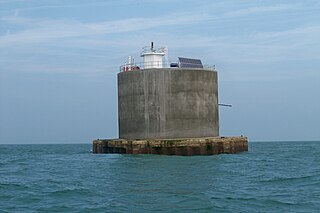
The Nab Tower was a tower planned for anti-submarine protection in the Solent in World War I. It was sunk over the Nab rocks east of the Isle of Wight to replace a lightship after the war, and is a well-known landmark for sailors as it marks the deep-water eastern entry into the Solent.

Carbide lamps, or acetylene gas lamps, are simple lamps that produce and burn acetylene (C2H2) which is created by the reaction of calcium carbide (CaC2) with water (H2O).
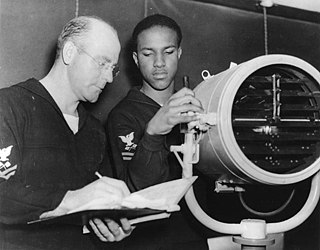
A signal lamp is a semaphore system using a visual signaling device for optical communication, typically using Morse code. The idea of flashing dots and dashes from a lantern was first put into practice by Captain Philip Howard Colomb, of the Royal Navy, in 1867. Colomb's design used limelight for illumination, and his original code was not the same as Morse code. During World War I, German signalers used optical Morse transmitters called Blinkgerät, with a range of up to 8 km (5 miles) at night, using red filters for undetected communications.

The lighting system of a motor vehicle consists of lighting and signalling devices mounted or integrated at the front, rear, sides, and in some cases the top of a motor vehicle. They illuminate the roadway ahead for the driver and increase the vehicle's visibility, allowing other drivers and pedestrians to see its presence, position, size, and direction of travel, and its driver's intentions. Emergency vehicles usually have distinctive lighting equipment to warn drivers and indicate priority of movement in traffic.
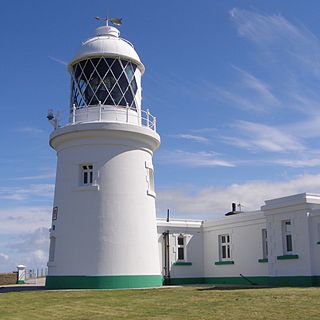
Pendeen Lighthouse, also known as Pendeen Watch is an active aid to navigation located 2 kilometres (1.2 mi) to the north of Pendeen in west Cornwall, England, United Kingdom. It is located within the Aire Point to Carrick Du SSSI, the Cornwall Area of Outstanding Natural Beauty and the Penwith Heritage Coast. The South West Coast Path passes to the south.

The Lizard Lighthouse is a lighthouse at Lizard Point, Cornwall, England, built to guide vessels passing through the English Channel. It was often the welcoming beacon to persons returning to England, where on a clear night, the reflected light could be seen 100 mi (160 km) away.

The arc converter, sometimes called the arc transmitter, or Poulsen arc after Danish engineer Valdemar Poulsen who invented it in 1903, was a variety of spark transmitter used in early wireless telegraphy. The arc converter used an electric arc to convert direct current electricity into radio frequency alternating current. It was used as a radio transmitter from 1903 until the 1920s when it was replaced by vacuum tube transmitters. One of the first transmitters that could generate continuous sinusoidal waves, it was one of the first technologies used to transmit sound by radio. It is on the list of IEEE Milestones as a historic achievement in electrical engineering.

The Big-Bang Cannon is an American toy cannon first manufactured in the early 20th-century. Numerous consumer fireworks injuries convinced a physics professor at Lehigh University to patent a "Gas Gun" in 1907, and the manufacturing of Big-Bang Cannons started in 1912, from the Gas Cannon Company.

A timeline of United States inventions (1890–1945) encompasses the ingenuity and innovative advancements of the United States within a historical context, dating from the Progressive Era to the end of World War II, which have been achieved by inventors who are either native-born or naturalized citizens of the United States. Copyright protection secures a person's right to his or her first-to-invent claim of the original invention in question, highlighted in Article I, Section 8, Clause 8 of the United States Constitution which gives the following enumerated power to the United States Congress:
To promote the Progress of Science and useful Arts, by securing for limited Times to Authors and Inventors the exclusive Right to their respective Writings and Discoveries.

Semaphore is the use of an apparatus to create a visual signal transmitted over distance. A semaphore can be performed with devices including: fire, lights, flags, sunlight and moving arms. Semaphores can be used for telegraphy when arranged in visually connected networks, or for traffic signalling such as in railway systems, or traffic lights in cities.

New Brighton Lighthouse is a decommissioned lighthouse situated at the confluence of the River Mersey and Liverpool Bay on an outcrop off New Brighton known locally as Perch Rock. Together with its neighbour, the Napoleonic era Fort Perch Rock, it is one of the Wirral's best known landmarks.

The J. B. Colt Company was a producer of lamps and acetylene products based in New York City, headed by James Bennett Colt and in operation from 1891 to 1911. Among its products was the Colt Acetylene Flash Lantern used by the American military.
The Electro-Dynamic Light Company of New York was a lighting and electrical distribution company organized in 1878. The company held the patents for the first practical incandescent electric lamp and electrical distribution system of incandescent electric lighting. They also held a patent for an electric meter to measure the amount of electricity used. The inventions were those of Albon Man and William E. Sawyer. They gave the patent rights to the company, which they had formed with a group of businessmen. It was the first company in the world formally established to provided electric lighting and was the first company organized specifically to manufacture and sell incandescent electric light bulbs.

Sidney Howe Short was an electrical engineer, inventor, physicist, professor and businessman. He is known for the development of electric motors and electric railway equipment. His inventions were so successful that even his competitors dubbed him "The Trolley King". He also developed telephone equipment much like that of Alexander Graham Bell. As a businessman he was president, key engineer, or advisor of different companies related to electrical equipment. It is claimed that he had nearly as many electrical innovations as Thomas Edison.
References
- ↑ Official Gazette of the United States Patent Office. The Office. 1904. pp. 612–.
- ↑ J. H. Dockweiler (1903). Report on Maneuver Division, Camp Root, Fort Riley, Kansas, September-October 1902. W.W. Shannon, Superintendent of State Printing. pp. 42–.